With so many different brands and shapes of resistance bands out there, is it possible to determine the weight of a resistance band simply by its classification? You sure can! This post explains how much weight a light, medium, and heavy resistance band adds to your exercises.
Resistance bands can add varying amounts of weight depending on their classification and brand. A light band usually provides 5-30lbs (2-14kg) of weight. A medium band typically gives 20-60lbs (9-27kg). And a heavy band can provide up to 50-100lbs (23-45kg), or more, of tension.
I’ve spent more than 5 years training with bands.
And let me tell you; having tried many of the different brands out there, it can sometimes feel like there’s a big weight discrepancy between them.
So I conducted my own (albeit small) market research study to find out exactly how much weight a resistance band actually is.
Let’s find out!
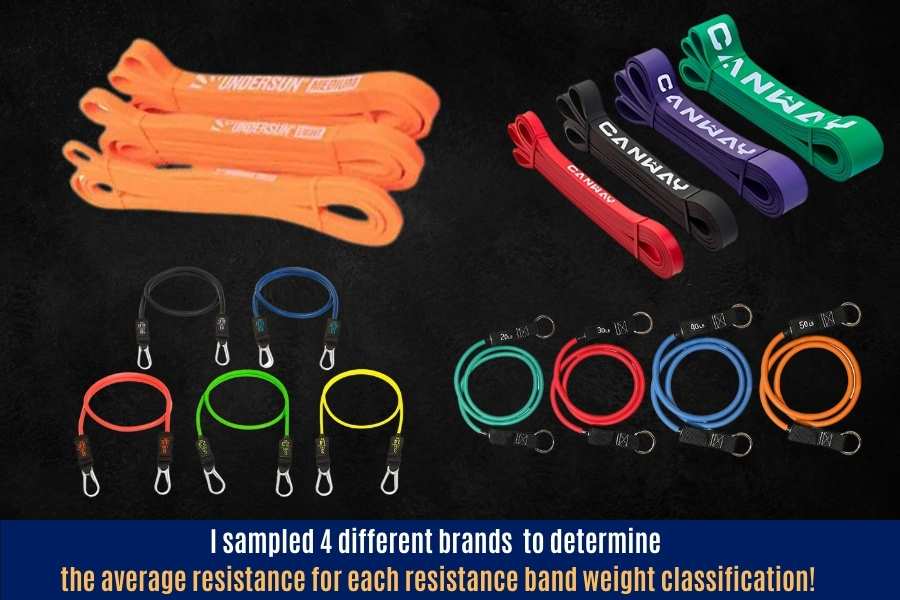
- Don't Want The Headache Of Choosing The Right Resistance Band Weight?
- Average Weight For A Light, Medium, And Heavy Resistance Band
- How Much Weight A Light Resistance Band Provides
- What Are Light Resistance Bands Used For?
- How Much Weight A Medium Resistance Band Provides
- What Is A Medium Resistance Band Used For?
- How Much Weight A Heavy Resistance Band Provides
- What Is A Heavy Resistance Band Used For?
- Should You Get A Light, Medium, Or Heavy Resistance Band?
- Best Resistance Band Set That Includes All Weights
- Conclusion
Don’t Want The Headache Of Choosing The Right Resistance Band Weight?
Resistance bands come in a variety of weights and sizes.
The sheer variety can be intimidating and difficult to navigate.
If you want a good set of affordable resistance bands that contain light, medium, AND heavy weights, then I use and recommend the Undersun Fitness bands.
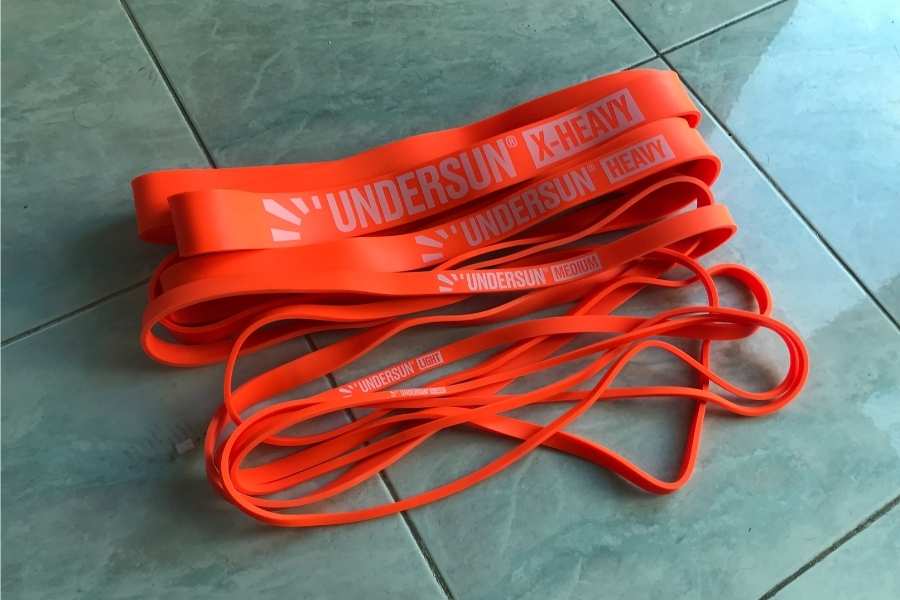
I’ve been using these for 2 years now and they’re by far my favorite (I’ve tried almost half a dozen brands).
And of course, keep reading to find out how much weight a light, medium, and heavy resistance band adds to your exercises!
Average Weight For A Light, Medium, And Heavy Resistance Band
To work out these average poundages, I conducted a simple comparison study for 4 popular sets of resistance bands:
- Undersun Fitness– a premium company known for its heavy-duty loop bands.
- Canway– a midrange company that makes loop bands.
- Bodylastics- a midrange company specializing in tube bands.
- GoFit– a budget company producing tube bands.
You can see that I sampled resistance band weights from a variety of brands, price points, and types (circular loop-style bands vs tube-style bands with handles).
This was done to get the fairest and most reliable representation possible.
I then compiled my results.
Here are the average weights for light, medium, and heavy resistance bands:
| Resistance Band Classification | Average Weight Range (lbs) | Average Weight Range (kg) | Typical Function |
|---|---|---|---|
| Extra light | 5-15lbs | 2-7kg | Casual fitness, fat-burning, and cardio. |
| Light | 10-30lbs | 5-14kg | Small exercises like bicep curls, fat-burning, and cardio. |
| Medium | 20-60lbs | 9-27kg | Increasing muscle size and tone in beginners. |
| Heavy | 30-70lbs | 14-32kg | Muscle and strength gains for intermediates. |
| Extra Heavy | 40-100lbs | 18-45kg | Muscle and strength gains for advanced lifters. |
It should be noted, however, that these are just averages.
In reality, resistance band weights vary greatly depending on brand and model.
For example, the popular TheraBands are relatively light compared to their competitors, as given by the averages above.
But one thing all bands share in common is that the weights should be given clearly by each brand.
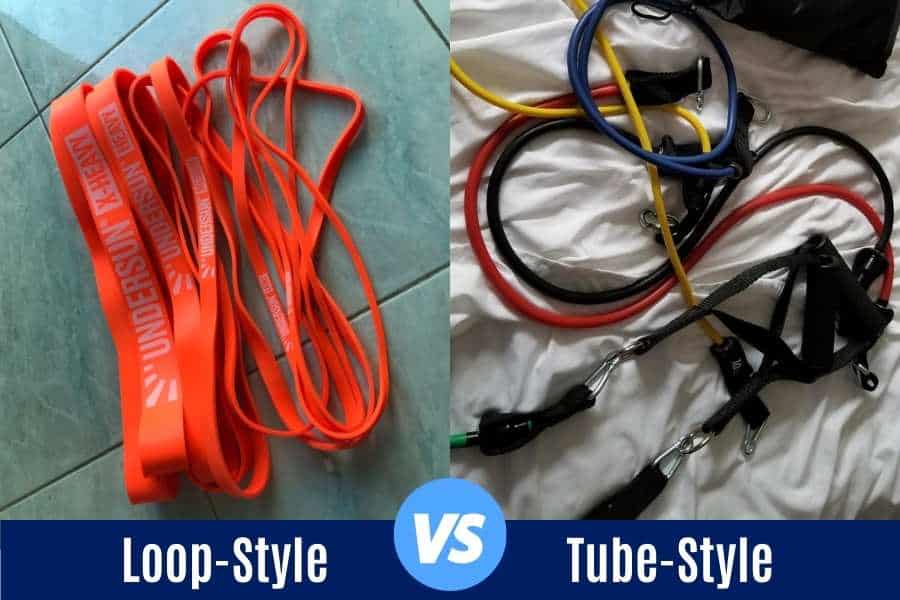
Additionally, it’s worth noting that circular loop-style resistance bands generally offer more weight than the tube-style bands with handles.
How Much Weight A Light Resistance Band Provides
Extra light and light resistance bands provide, on average, 5-30 pounds (2-14kg) of weight. But this varies depending on the style of the band. A light loop-style band usually has a maximum resistance of around 30lbs compared to tube-style bands which usually provide up to 15lbs.
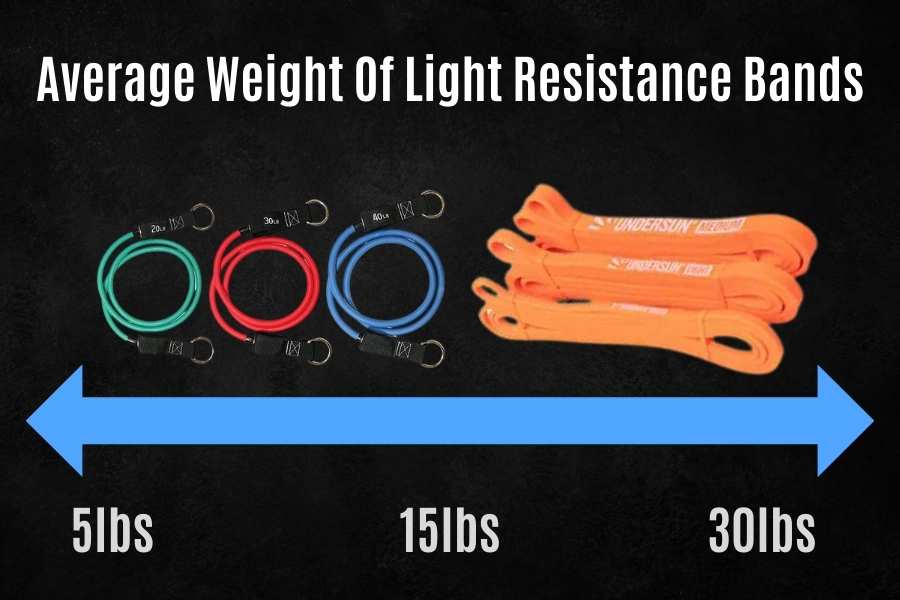
Therefore resistance bands that add 5-30lbs of weight are generally considered to be light.
Resistance bands that reside on the lower end of that spectrum are usually considered “extra light”, whilst those that belong to the upper end of the spectrum are simply considered to be “light”.
As always though, the exact weight of an “extra light” or “light” resistance band will vary greatly depending on the manufacturer.
Light resistance bands are either labeled or color-coded blue or yellow.
But again, resistance band weight-color coding varies between manufacturers.
So make sure you check the product information for the exact pounds a resistance band will give you!
What Are Light Resistance Bands Used For?
Light resistance bands are best used for cardio, fat-burning, and small muscle-building exercises like bicep curls. They are ideal for beginners to start training with. These resistance bands can also be great for those who are interested in working out for casual fitness.
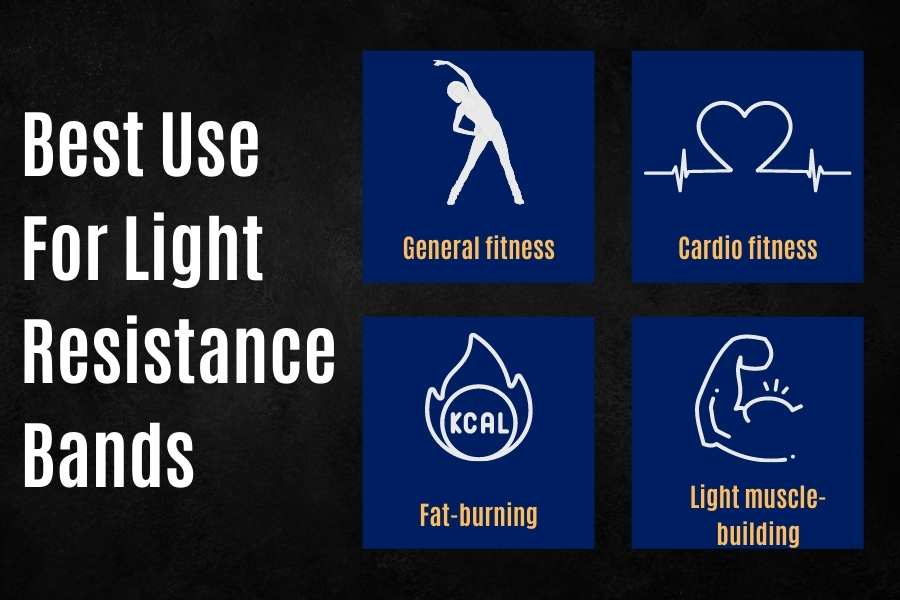
A light resistance band can provide a novice (someone with less than 6 months of training experience) with a good amount of weight to begin their training journey.
Whether your goal is to begin building some light muscle and tone, lose fat, or just improve your cardiovascular endurance; a light resistance band can get you started.
These kinds of resistance bands can also work well for intermediates (someone with 6-12 months of training experience) to build muscle on small isolation-type movements that target specific muscles like the biceps or deltoids.
These are my recommendations for how to use light resistance bands:
- General fitness. Performing 15-minute workouts every other day with a light band can confer strength, mobility, and balance benefits. Band presses, squats, and rows are easy for a beginner to start with!
- Cardiovascular training. Use a light band to perform compound movements at 30+ consecutive repetitions with no rest. Squats, lunges, and lower body movements in general work great for increasing your heart rate.
- Fat-burning. HIIT-style circuit workouts work well with light resistance bands. These types of resistance band workouts are ideal for burning belly fat and increasing muscle tone.
- Muscle-building. Light resistance bands are ideal for small movements like bicep curls, lateral raises, tricep extensions, and chest flyes!
How Much Weight A Medium Resistance Band Provides
Medium resistance bands provide, on average, 20-60 pounds (9-27kg) of weight. But the exact weight can vary based on the style of the band. Medium loop-style bands usually have a maximum resistance of around 60lbs compared to tube-style bands which usually provide up to 40lbs.
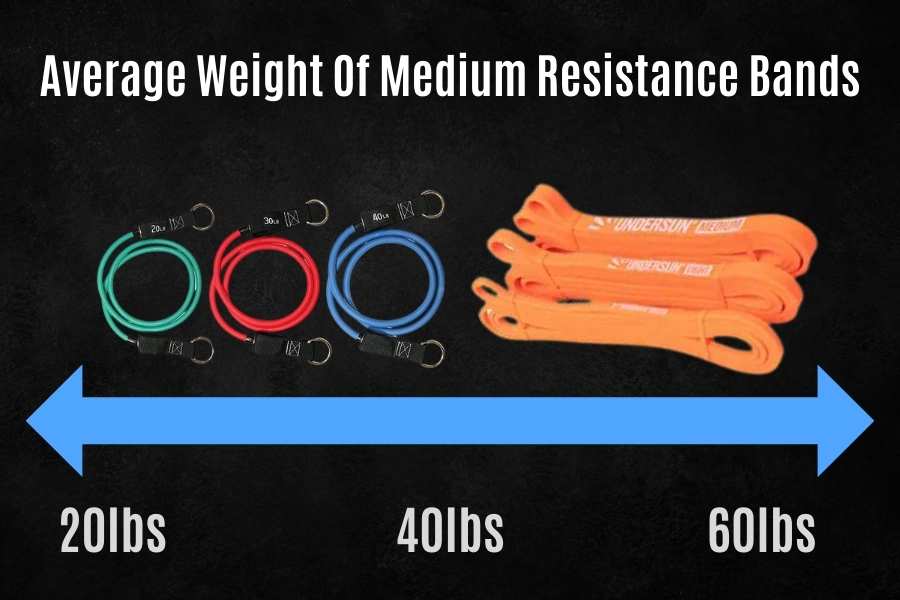
Therefore resistance bands that add 20-60lbs of weight are generally considered to be medium or moderate.
As with all resistance bands, however, you should check the product description.
Why?
A weight that one resistance band manufacturer considers to be medium may be up to 30lbs or more lighter/heavier than another brand!
Generally speaking, medium resistance bands are either labeled with the word “medium” or color-coded green or red (color codes vary between manufacturers though).
Therefore it’s good practice to check the product description to be sure how much weight a particular resistance band will provide you!
If you’re not sure why resistance band weights are given as a range, you can check out my other post on what the weight on a resistance band means!
What Is A Medium Resistance Band Used For?
Medium resistance bands are best used for building muscle and tone in beginners as well as intermediates. They can be used for a range of exercises that target all of the muscles in the body. This versatile band weight may also be used for cardio and fat-burning purposes.

A medium resistance band provides a novice (someone with less than 6 months of training experience) with an appropriate amount of weight to build their muscles with large compound-type movements like band presses, rows, and squats which target multiple muscle groups at once.
A medium resistance band weight is also suitable for intermediates (someone with 6-12 months of training experience) to tone their muscles with small isolation-type movements like bicep curls when a light resistance band is no longer challenging enough.
These are my recommendations for how to use medium resistance bands:
- Building muscle size in beginners. Focus on performing compound exercises like pressing, rowing, squatting, and deadlifting movements. Aim for 8-12 reps per set and 3-4 sets per exercise. Take a 1-2 minute rest between sets.
- Increasing muscle tone in intermediates. Follow the above guidelines for beginners to build muscle size. But prolong the upward and downward tempo to 3 seconds each (6 seconds total). This is called time under tension training (TUT) and works well for increasing muscle tone!
- Fat-burning and cardio. See previous recommendations in “what are light resistance bands used for”.
If you are new to band training, you may be interested in my other article which shares my favorite beginner’s resistance band exercises with pictures!
How Much Weight A Heavy Resistance Band Provides
Heavy and extra heavy resistance bands provide around 30-100 pounds (13-45kg) of weight. The amount of weight provided varies depending on the style of the band. A heavy loop-style band usually has a maximum resistance of around 120lbs compared to tube-style bands which usually provide up to 60lbs.
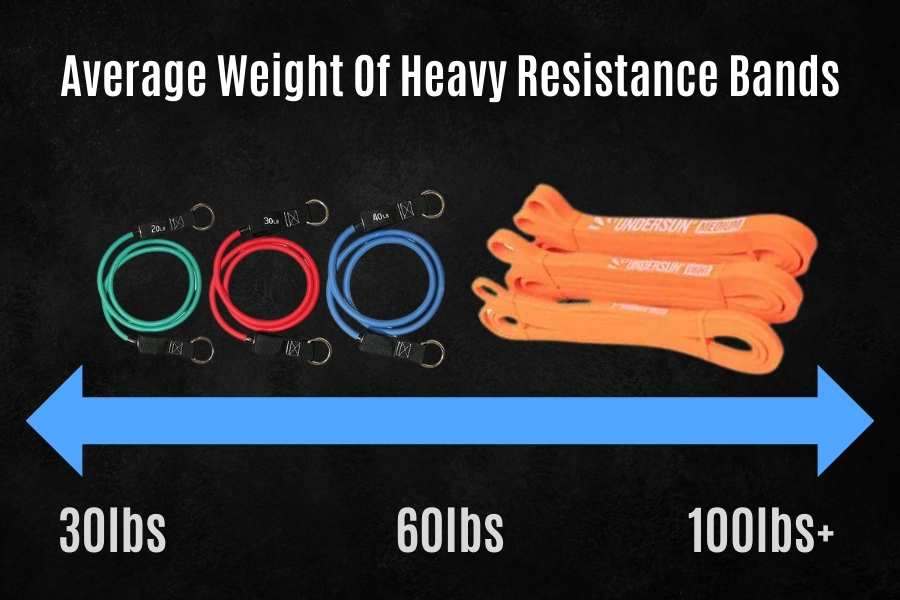
Therefore resistance bands that add 30-100lbs of weight are generally considered to be heavy or extra heavy.
Resistance bands that reside on the lower end of that spectrum are usually considered “heavy”, whilst those that belong to the upper end of the spectrum are simply considered to be “extra-heavy”.
However, as you should know by now, resistance band classifications can vary widely between manufacturers.
So make sure you research the product information to see how many pounds of resistance a particular band will give you!
Heavy and extra heavy resistance bands are either labeled with the words “heavy” or “extra heavy”. Or they’re usually (but not always) color-coded with red or black.
What Is A Heavy Resistance Band Used For?
Heavy and extra heavy resistance bands are best used for building muscle and strength. They are ideally used for large compound exercises, but they can also be used for smaller isolation-type movements like the bicep curl. Resistance bands at this weight can also be used for toning and burning fat.

A heavy resistance band is generally not that useful for someone who’s just started training since the tension tends to be more than they can cope with.
However, heavy bands can still be used by beginners to do pressing, pulling, squatting, and deadlifting movements at low reps to build strength.
And of course, a beginner will eventually need to move onto heavy and extra heavy resistance bands to build serious muscle and strength.
Heavy and extra heavy resistance band weights are utilized most effectively by intermediate-advanced lifters who have more than 12 months of experience.
These people generally have a good foundation of strength to build from.
And they require heavy bands to keep their muscles challenged for continuous growth.
These are my recommendations for how to use heavy resistance bands:
- Building muscle size. Focus on the large compound exercises like the chest press, shoulder press, back row, squat, and deadlift. Aim to complete 8-12 reps per set with a good controlled form and a full range of motion. Aim for 3-4 sets per exercise with a 1-2 minute rest in between sets.
- Increasing strength. Building muscle size (hypertrophy) and strength are highly related processes. Therefore exercise choice should again focus on the compound movements. To emphasize strength, reduce to 5-6 reps per set and use a resistance band weight that challenges you for those reps. Aim for 5 sets per exercise and 3 minutes rest in between sets.
Feel free to check out my other article to learn how to use resistance bands to build strength!
Should You Get A Light, Medium, Or Heavy Resistance Band?
Beginners should generally start with a light to medium resistance band weight. These provide around 5-60lbs of resistance and allow the user to safely and effectively perform most exercises. To maximize muscle size and strength, it is recommended to progress onto heavy resistance bands.
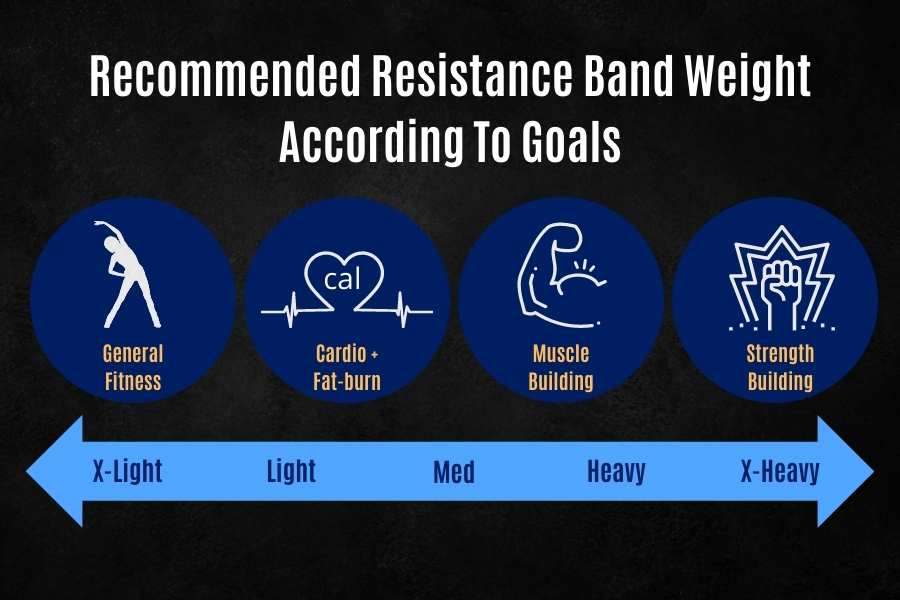
Look.
Resistance bands confer a wide range of benefits that range from mobility improvement to strength gains.
Your future training goals and current fitness level should influence whether you get light, medium, or heavy weight resistance bands.
Generally speaking, those who are looking to build muscle and strength require a heavy resistance band weight, compared to those who are looking to lose weight, tone, and improve their cardio requires a light resistance band weight.
To avoid the headache of having to choose single bands and avoid picking an unsuitable band weight for your goals, I highly recommend getting a set.
Best Resistance Band Set That Includes All Weights
In my 5+ years of resistance band training, I’ve gone through more sets than I would’ve liked.
I’m not proud of this.
But it’s also taught me a lot about what is good, bad, and downright ugly.
Having tried both cheap and expensive brands, I can honestly say the slight extra premium on a good set is well worth the money.
I currently use and recommend the Undersun Fitness bands.
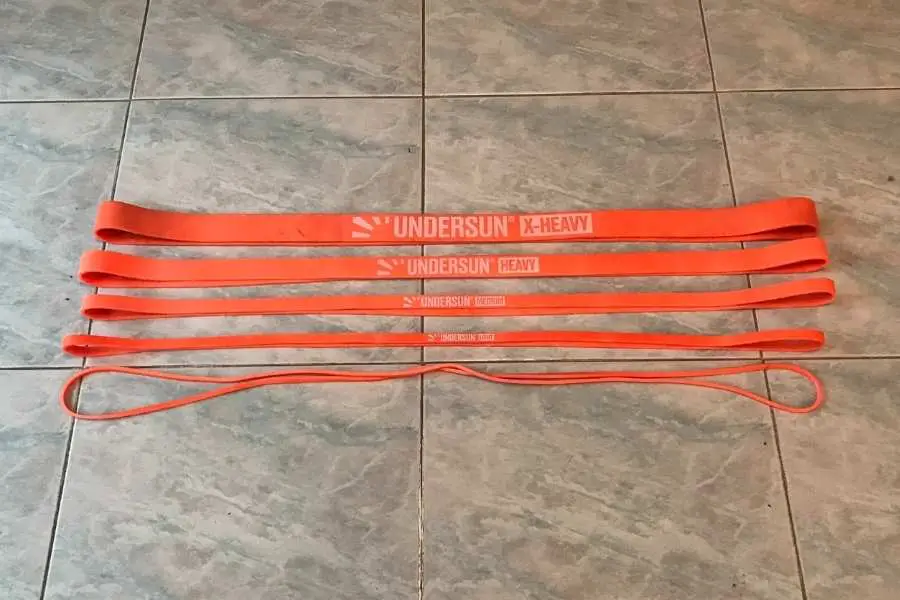
The set comes with 5 bands at different resistance levels (extra light to extra heavy). This is enough for people of all training levels to achieve most training goals.
Looking to build muscle? Increase strength? Burn belly fat or improve your cardio? Or maybe you just want a durable set of bands to improve your health and fitness?
These bands will do the job.

The lighter bands in the set are perfect for beginners. But the heavy bands also give you the freedom to make strength gains so you don’t pigeonhole yourself in the future. You can also combine multiple bands to create insane resistances.
And the best thing about them?
They come with a lifetime warranty!
Conclusion
I’ve explained how much weight is provided by an extra light, light, medium, heavy, and an extra heavy resistance band.
Light bands are typically considered to provide 5-30lbs (2-14kg) of resistance, medium bands 20-60lbs (9-27kg), and heavy bands around 30-100lbs (14-45kg).
But these are just averages.
In reality, each manufacturer has slightly different resistances for each classification of resistance band weight.
So make sure you check the product description for your bands!
What resistance band weight will you be getting?
Feel free to send me a message if you have any questions! You can find my details on the “contact us” page.
You may also be interested in the downloadable Kalibre Blueprint PDF which details exactly how I gained 40lbs of lean muscle (it’s 100% free!). It details the exact exercises and nutrition (with printable worksheets) I used to go from skinny to ripped!
Thanks for reading guys!
Peace Out,
Kal
(Biochemistry BSc, Biomedical Sciences MSc, Ex-Skinny Guy)


